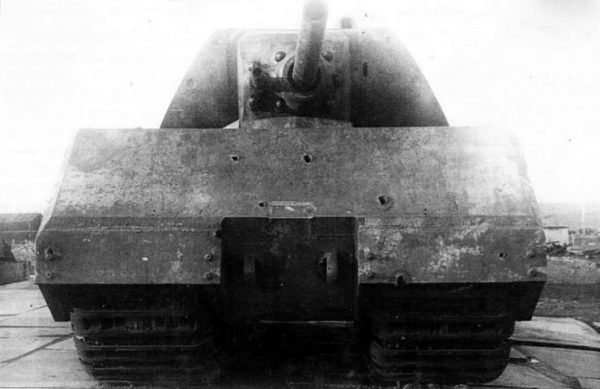The one tank that shook the world to its core, when it took its first test - drive through the vast roads and pathways of Nazi Germany, making thunder every smack of the tread on the ground, the Panzerkampfwagen V l l l Maus was born. Existing in the extreme heat, near the end, of WW2, 1944, the newly invented Maus (Panzer V l l l) was roaming around the streets of Germany in its final Nazi stages, and came into existence relatively quietly.
The Maus tank was made and constructed in secrecy because it was made to be the heaviest land vehicle to ever exist. The Maus tank was created to have the best armor and a very over-the-top main cannon to help protect itself and destroy anything in its way. The main reason it was conceived was because at the time, the USSR had been advancing in tank technology very quickly and were making more tanks that had better armor, stronger guns, and were getting faster at the same time. This was a huge problem for Germany because the USSR was becoming a very difficult combatant to deal with, which would also eventually lead to their downfall if they did not act soon with something. At this point in panic, the Maus tank was made. Plans for the project were quickly conceived and not very long, as being very tight on schedule, blueprints were then made and actions for the project started taking place. The Maus first was planned to have a flamethrower on it as an addition to its 150 mm main gun, however, after consideration and costs, the idea of a flamethrower was quickly removed, and instead replaced with a smaller gun.
Production of the Muas was set in 1943, being first introduced as a secret super weapon to fight against anything and anyone it was faced against. The Maus was kitted with a staggering 150 mm gun that could penetrate just about anything that was in its path, having roughly 130 mm of actual penetration, with an additional 75 mm coaxial gun mounted to the front. The Muas was also equipped with an insane 200 mm of armor, as an example, this is equivalent to stacking five doors, on the flat side, together. To put this into perspective, the average medium tank near the end of WW2 (1945) had about 60 mm thick armor and was equipped with a 75 - 85 mm gun, sometimes with a 50 cal mounted-machine gun on top. This was a huge upgrade up to this point, even just the secondary gun on the Maus was about as big as the average gun on a medium tank at this time period. The armor is also about two and a half times thicker and stronger than the average thickness of a light tank.
As good as the Maus sounded, it had some major drawbacks regarding its strengths and some huge weaknesses that were so bad to the point that there were only two ever made, and only one seeing the end of the war. During its time in WW2, there were two Maus’s to ever be made, however only one of them would come out of the war “alive”. The Maus had crazy thick armor and an insanely big gun because it was seen to be the wonder weapon, however, what German scientists forgot about was movement. Because of the Maus’s unconceivable weight of 188 tons, it took a lot of force to get the tank to move. The Maus had a 1,750 horsepower engine, which even for today's standard is absolutely insane, however even with all of the power it gained from the engine, it still only moved at a top speed of fifteen and a half miles per hour, which is far from sufficient enough for a tank to actually be considered good. A tank going that slow on the battlefield was basically a free target to hit, and even the slowest of tanks in WW2 could go at least twenty miles per hour, at which the Maus goes four fifths of that. The rotating turret on the top of the main shell also moved very slowly, losing a ton in mobility for mid combat situations. The rotating turret on the top of tanks is what usually makes tanks distinguishable to other vehicles. Usually the ammunition is stored in the turret and sometimes in the main hull if there is an overflow of ammo. When there is not a lot of mobility in the rotating turret, it is much harder to actually hit targets that are moving or even just generally hitting targets. Going back to the mobility problem that it was just a standing target, that is the sole reason that the Maus actually was taken out by an intense bombing after the USSR was closing in on the tank.
The Maus was the heaviest tank in all of world history, both literally and figuratively, and was a staple in engineering during WW2. The Maus shows the drastic measures that countries will go to just to win a war. If the Maus was ever actually made, it possibly would have been an, okay at most tank, however, due to its testing being postponed by bombings and the end of the war, the plans for making it never went into effect. The Maus was only made as two prototypes, however, one was destroyed in testing, and the other was destroyed in fear that the USSR was going to take and steal the design of the Maus and use it against them, if the Germans had not lost the war soon after being compromised. Also, the Maus was a descendent of the panzer family, being the eighth one.
Work Cited
Candlin, Alex. “The super heavy Panzer VIII Maus, Hitler's secret monster tank that never saw combat.” Forces Network, 10 July 2023, https://www.forces.net/heritage/wwii/adolf-hitlers-secret-monster-tank-super-heavy-panzer-viii-maus. Accessed 14 March 2024

